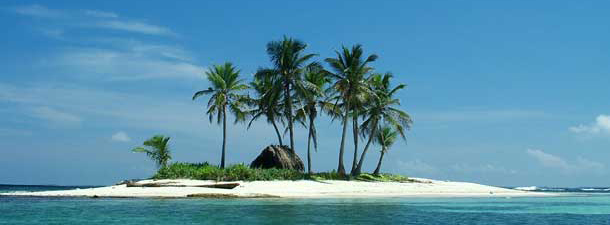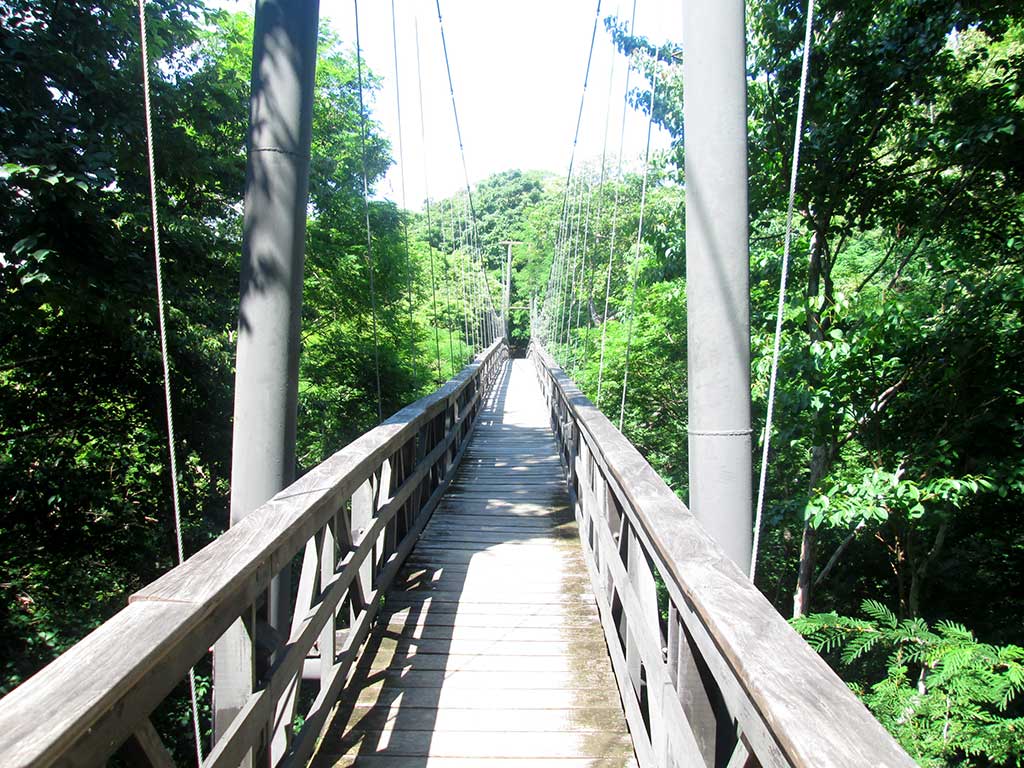
Traveling to Nicaragua is easier than ever
August 4, 2022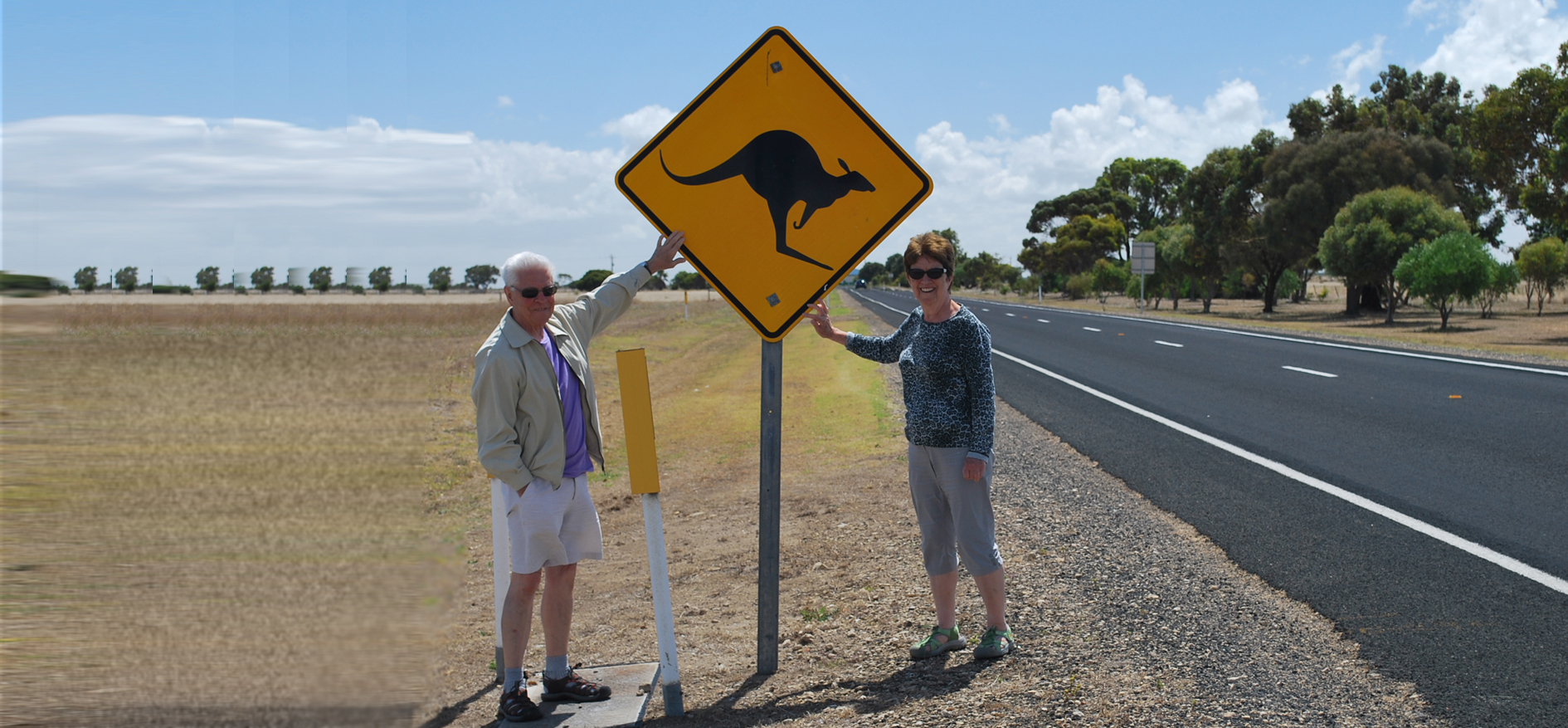
A Very Long Way Home
August 8, 2022The indigenous Guna people in Panama have banned foreign land ownership. After a long struggle, they have carved out a homeland for themselves, where they jealously guard their prerogatives. The result is a resort-free tropical paradise, and a travel experience that can be found nowhere else.
T
The San Blas islands are the Caribbean equivalent of the Maldives but who, in all honesty, has ever heard of them? Search Google Maps and zoom in on the remote northeastern Panamanian coastline and all you’ll find is a handful of islands with lazily-drawn, straight shorelines. You’d never guess that an entire archipelago of nearly 400 idyllic cays lies strung like a coral necklace all the way to the Colombian border. The islands are a Robinson-Crusoe cliché. Leaning coconut palms cast shadows on powdery white beaches while lobster fishermen in dugout canoes paddle along reefs in shallow, opalescent lagoons. This could be luxury honeymoon heaven, but it isn’t. International hotel chains have hungrily eyed these pristine islands for decades but on every occasion that they’ve attempted to develop the islands, the indigenous Guna people have resisted their fistfuls of dollars.
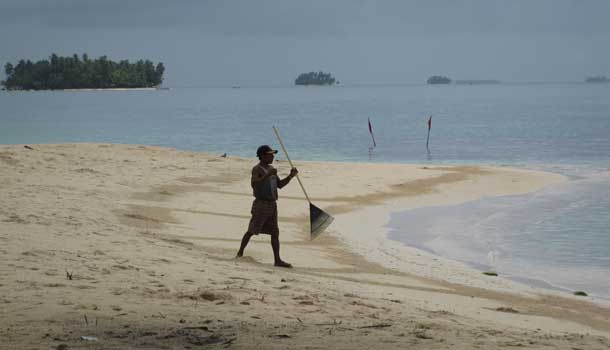
Carti Sugdup
A glance at the Guna’s history explains this reticence. From the day Spanish Conquistadors first set foot on the Guna’s ancestral homelands in Colombia, their land was plundered by prospectors in search of gold, rubber and any other lucrative commodities they could get their hands on. Centuries of violent confrontation ensued, and in 1870, the Colombian government was forced to grant the Guna a semi-autonomous comarca (indigenous homeland) which guaranteed their land rights. When Panama seceded from Colombia in 1903, its cash-strapped government reneged on the treaty and granted land concessions to outsiders. Once again this led to armed insurrection, and in 1925 the Guna rose up en masse and declared independence. Mediation by the United States led to the creation of the Guna Yala – a virtually independent nation within Panama, which today is the envy of indigenous people throughout Latin America. Governed by a council of elders, the Guna strictly forbid foreign ownership of land. Bar the odd cruise liner dropping anchor offshore, tourism development remains firmly in the hands of the Guna themselves.
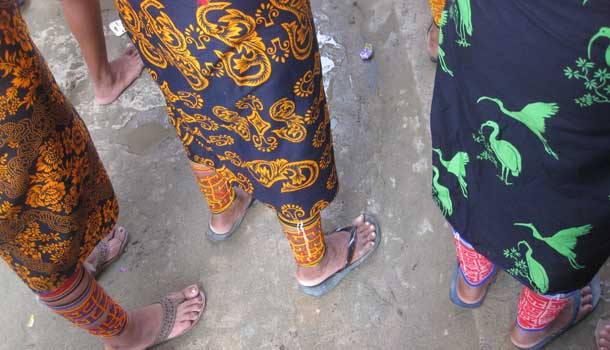
Leg bands Carti Sugdub
Whether travelling by plane or overland by jeep, getting to the Guna Yala is an adventure in itself. At six in the morning I found myself in a Toyota 4×4, speeding along the Pan American highway on Panama City’s spectacular ocean drive, the Corredor Sur. The sun was just rising over the Pacific Ocean and flocks of hungry pelicans were swooping low over the waves in search of their first catch of the day. Ahead of us flashes of orange sunlight sparkled in the windows of futuristic skyscrapers lining the Costa del Este, Panama City’s latest property hotspot. Panama City has long been a favourite location for property speculators, and as we sped past I couldn’t help wondering how many millions of dollars of floundering banks’ assets were tied up in these breathtaking white elephants.
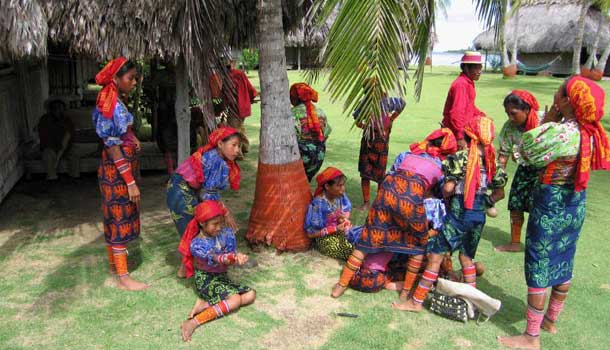
Guna Girls – photo Bruce Taylor
As soon as you leave the Costa del Este, Panama City quickly dissolves into the usual ramshackle muddle of Latin American suburban life. Entire local economies depend on the Pan American Highway, which is lined with dusty garages and rickety stalls piled high with mouth-watering fruit displays. Local women are a godsend for hungry lorry drivers and the highway is lined with makeshift fondas (inns) bearing their owners’ names. We’d all missed breakfast so were glad when our driver drew up at Fonda Alicia, which was doing a brisk trade in steaming plates of huevos rancheros for a group of tattooed labourers. The coffee in these roadside fondas is universally good, and revived by some velvety smooth cafes con leche we left the Pan American Highway and headed inland towards the verdant foothills of the San Blas Mountains.
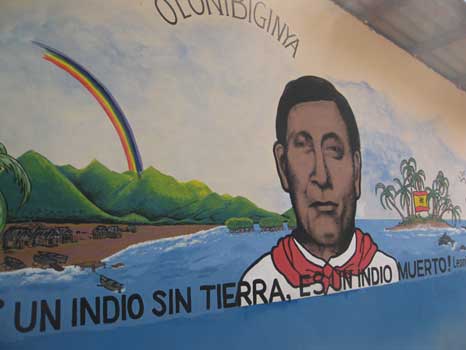
An Indian without land is a dead Indian
Our driver was in a good mood and decided to treat us to some of his favourite music CDs, mostly compilations of impassioned Latin rock songs. I was particularly moved by a despairing rock chick who’d recently been dumped by her boyfriend and proceeded to wreak revenge by hurling basketballs at her ex-boyfriends, hitting them all painfully where it hurts. The newly asphalted El Llano-to-Cartí road that links the Pan American Highway to the Caribbean has revolutionised access to the Guna Yala – in theory that is. The rainy season had arrived early and as we ascended higher into the mountains the road’s vulnerability was all too plain to see. Alarming landslides had swept away whole chunks of road while in the valleys bright red ponds had accumulated, totally submerging the road’s surface. Careering through these mini-lakes was thrilling, but as we headed higher into the San Blas cloud forest the road turned into a terrifying ride of sharp angles and sudden swerves worthy of the Monte Carlo Grand Prix. It was all too much for one of our group, an elfin faced Spanish girl, who called out for our driver to stop and headed to the side of the road for a lengthy bout of vomiting.
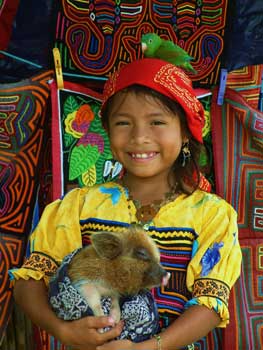 Guna girl and piglet |
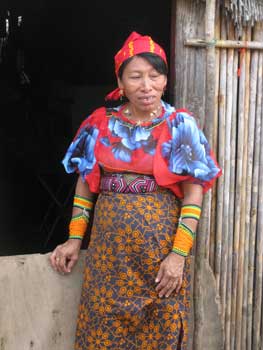 Carti Sugdup woman |
At the tiny village of Nusugandi we entered Guna Yala territory. I was surprised at the strictness of the border controls. A fearsome-looking woman dressed from top to toe in army camouflage swaggered towards our jeep, a rifle slung menacingly over her shoulder. One by one, she slowly scrutinised our faces through the jeep’s windows as she suspiciously checked each of our passports. I dearly wanted to ask for a passport stamp, but somehow felt that this was not a lady to be trifled with. Eventually she waved us on and we began our descent to the coast. Soon magnificent panoramas of the San Blas islands came into view, framed by anvil-shaped storm clouds scurrying in from the Caribbean.
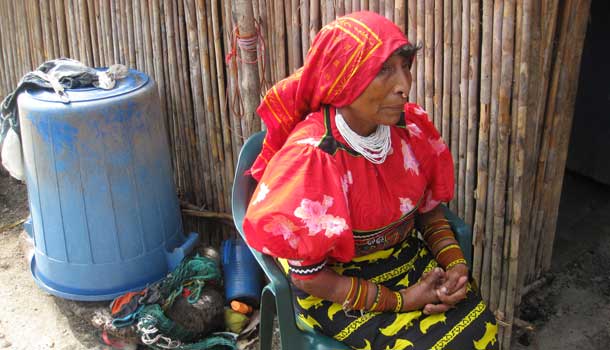
Local woman with nosering
The first heavy drops of warm tropical rain were just beginning to fall as we arrived in the bustling port village of Barsukum. The jetties were a hive of activity as Guna women laden with sacks of produce jumped into outboard riggers, trying to set out before the heavens burst. The traditional costumes of Guna women have become proudly-worn symbols of indigenous culture. In the worsening light, the vivid colours and patterns shone out with extra vibrancy. Around their heads, the women tie scarlet and gold scarves while many older women still wear golden nose rings. The most striking features of the costumes are the molas, richly embroidered bands of cloth stitched onto the waists of puff sleeved blouses. These are covered in striking geometric patterns which have an ancient lineage dating back to ancestral body paint designs. To complete the outfits, the women wear colourful wrap-around skirts and dozens of bands of beads wrapped tightly around their arms and legs. Not surprisingly, on the morning of our arrival the ladies were anxious to avoid getting their gorgeous apparel spoilt by sea water. As the boats sped out into the choppy waters, they nervously clutched expansive plastic sheets up to their chins.
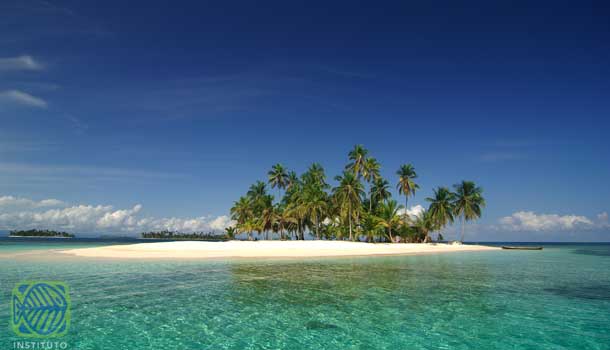
Guna Yala island
Staying in the Guna Yala involves sleeping in simple wooden cabanas and spending lots of time idling around on dazzlingly beautiful beaches. As we arrived on Aguja island, which seemed to consist of about fifty coconut palms and a handful of huts, an elderly American couple were sprawled out in deckchairs on the beach optimistically hoping that the sun would come out. Following a simple lunch of rice, plantains and tasty barbequed fish, we headed off to Carti Sugdub one of a handful of densely populated islands where the majority of the Guna live. The narrow streets were a hive of activity. Our visit coincided with a gathering of caciques (chiefs) and the village was gearing up for an evening of celebrations. The Guna live highly communal lives and most of the open plan bamboo and thatched houses had their doors wide open, offering tantalising glimpses of village life. Wandering down the narrow alleyways we spotted angelic-faced children swinging in hammocks, enjoying the cool sea breezes while their grandmothers sat at wooden tables, diligently stitching intricate molas.
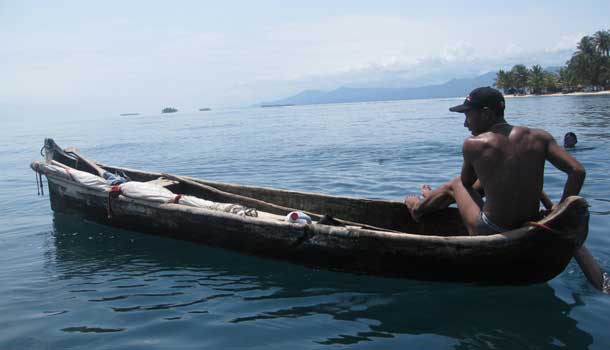
Lobster fisherman
When visiting Guna communities, it’s important to respect local sensibilities concerning photography and filming. Many still believe that if their image is captured, part of their soul will be lost. As we walked along, many women cast their heads down and covered their faces. Others were happy to be photographed, but it’s customary to ask permission first, and always offer a dollar for the privilege. At the village square, some men were more forthright and asked us crossly to put our cameras away. Crowds had gathered for a dance display by local teenagers. Along one side of the square, a group of girls wearing dazzling emerald and scarlet dresses were lined up. On the other side a group of boys in baseball caps and baggy shorts faced them. Some of the boys were carrying giant pan pipes, and with a hop and skip they launched into a cheerful staccato tune. Slowly they increased the tempo. As the girls gracefully twirled around, the boys, still playing their pan pipes, began leaping and spinning in an extraordinary display of athletic and musical prowess.
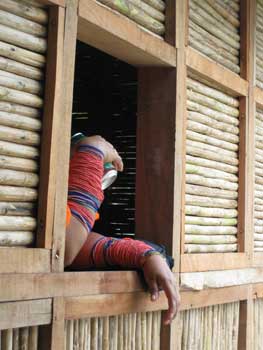
Carti Sugdup woman
The following day was one of those classic Caribbean days of crystal clear skies and sparkling seas. One of the great pleasures of the Guna Yala is jumping into a boat and sailing off into the archipelago to discover your perfect tropical island. Many of these are occupied by just one family who, for a small charge of one or two dollars, allow visitors to laze around all day on the pristine beaches and snorkel around the colourful reefs – diving is forbidden in the Guna Yala. It’s a small price to pay for a slice of paradise. At Ansuelo Island, the previous day’s storm had left exquisite pink-lipped Queen conches strewn on the sand, while just offshore shoals of butterfly and angel fish were curiously probing a piece of driftwood caught on the reef. In the lagoon, a father was patiently teaching his daughter how to canoe while the mother looked on proudly from the veranda of their wooden hut. After a swim around the island I flopped into a rectangular hammock slung between two palm trees. It was the most comfortable one I’d ever snoozed in. After half an hour or so, the father came over to collect my visitor’s dollar and ask me if I’d like a coconut drink. I felt glad that international tourism interests had made so few inroads in developing the Guna Yala; it would be impossible for these tiny fragile islands to sustain any significant development. Lying in my hammock, sipping a coconut as a guest of a local family, I felt that this was about as close to ecotourism as I was ever likely to get.
[note]
For more information on the Guna Yala visit
[/note]
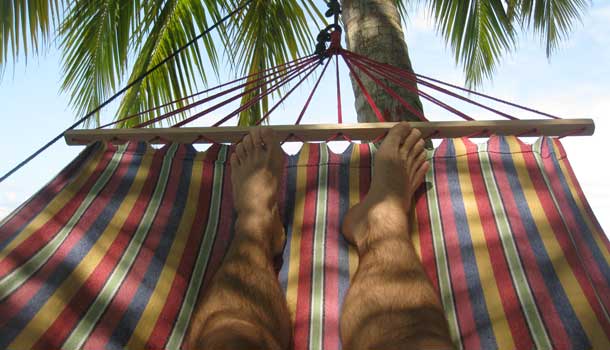
Relaxing on hammock in Ansuelo Island



